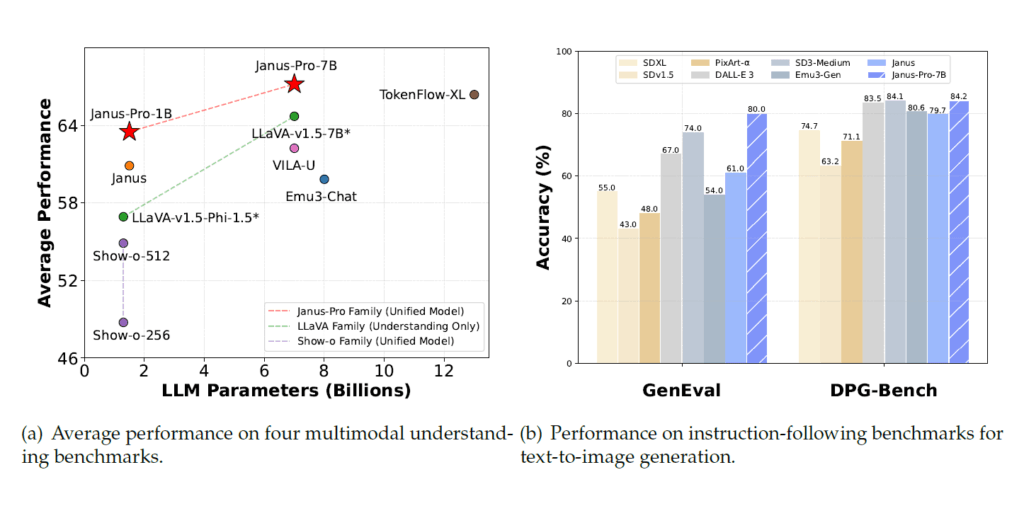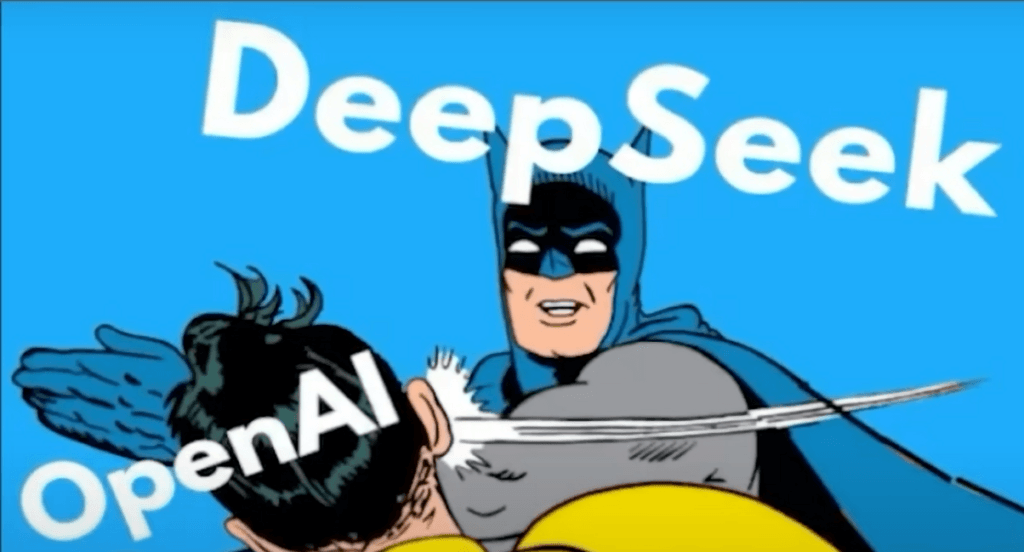Introduction: A New Contender in the AI Arena
In an industry dominated by tech titans like OpenAI, Google, and Microsoft, a Chinese startup named DeepSeek is making waves with its groundbreaking AI model, Janus Pro. Touted as a unified multimodal system capable of both understanding and generating images, text, and data, Janus Pro isn’t just another AI tool—it’s a direct challenge to the status quo.
Trained on a fraction of the budget of its competitors and leveraging open-source frameworks, Janus Pro has already outperformed DALL-E 3, Stable Diffusion, and Google’s EMU-3 in key benchmarks. But its real power lies in its ability to democratize AI, proving that cutting-edge innovation doesn’t require billion-dollar budgets or exclusive hardware.

This article dives into Janus Pro’s architecture, benchmarks, and real-world applications, while exploring its seismic impact on the AI industry, global markets, and the ongoing U.S.-China tech rivalry.
What is Janus Pro? A Unified Multimodal Powerhouse
Janus Pro is a 7-billion-parameter multimodal AI model developed by DeepSeek, designed to handle both visual understanding (analyzing images) and visual generation (creating images from text). Unlike traditional models that specialize in one task, Janus Pro unifies these capabilities in a single framework, making it a versatile tool for industries ranging from education to healthcare.
Key Innovations
- Decoupled Visual Encoding:
Janus Pro separates visual processing into two pathways—one for understanding (e.g., object detection) and another for generation (e.g., image synthesis). This eliminates conflicts between tasks, improving accuracy and stability. - Autoregressive Architecture with Rectified Flow:
Combining autoregressive language models with rectified flow (a state-of-the-art generative technique), Janus Pro achieves smoother, higher-quality outputs. - Cost-Efficient Training:
Trained in just 14 days on 32 NVIDIA A100 GPUs (costing approx. 120,000), Janus Pro proves high-performance AI doesn’t require OPENAI’s rumored 100M+ budgets.
Performance: How Janus Pro Stacks Against DALL-E 3, Stable Diffusion, and EMU-3
DeepSeek’s internal benchmarks reveal Janus Pro’s dominance in critical areas:
1. Text-to-Image Generation
- GenEval Benchmark: Janus Pro scored 80% in prompt adherence, surpassing DALL-E 3 (54%) and Stable Diffusion XL (55%).
- DPG-Bench: Outperformed competitors in detail accuracy, particularly in rendering textures like fur, fabrics, and lighting.
Real-World Test: “A majestic snow leopard in the Himalayas”
- Janus Pro: Delivered cinematic lighting and detailed fur but struggled with resolution (384×384 pixels).
- DALL-E 3: Produced sharper, fantasy-style images with higher resolution (1024×1024).
- Ideogram: Balanced realism and artistry but lagged in dynamic compositions.

2. Multimodal Understanding
- MMBench: Achieved 79.2% accuracy in visual question-answering tasks, rivaling GPT-4 Vision.
- POPE: Scored 87.4% in object recognition, outperforming specialized models.
Case Study: Explaining Memes
When shown a meme of “DeepSeek slapping OpenAI,” Janus Pro accurately dissected the visual metaphor, identifying competitive undertones and cultural context. However, it struggled with abstract interpretations, providing literal descriptions where GPT-4 inferred deeper symbolism.

3. Efficiency
- Hardware Flexibility: Runs on NVIDIA’s H800 chips (less powerful than restricted H100/A100 models), challenging the notion that advanced AI requires top-tier hardware.
- Speed: Generates images in 2-4 seconds on AMD’s Instinct MI300X GPUs, making it ideal for real-time applications.
The Open-Source Advantage: Why Janus Pro is a Game-Changer
Unlike OpenAI’s closed API models, Janus Pro is MIT-licensed, allowing developers to:
- Modify and redistribute the model freely.
- Integrate it into commercial apps without restrictions.
- Fine-tune it for niche use cases, from medical imaging to e-commerce.
DeepSeek’s decision to open-source Janus Pro has sparked a community-driven innovation wave. Developers are already experimenting with:
- Upscaling resolution to 768×768.
- Enhancing artistic refinement by training on anime and 3D art datasets.
- Adding plugins for ChatGPT-style conversational interfaces.
Market Impact: Shaking Up the AI Industry
Janus Pro’s release triggered a $593 billion sell-off in tech stocks, including NVIDIA, as investors questioned the necessity of expensive AI chips and billion-dollar R&D budgets.
1. Cost Efficiency vs. Big Tech’s Spending Spree
- DeepSeek’s R1 Model: Matched GPT-4’s performance at 1/20th the cost.
- Janus Pro: Built for under $150K, challenging OpenAI’s “bigger is better” ethos.
Industry Reaction:
- Sam Altman (OpenAI): “We’re doubling down on compute power—scale still matters.”
- Meta/Google: Allocated $310B for AI infrastructure by 2025, betting on brute-force scaling.
2. Geopolitical Implications: U.S.-China Tech War
- Circumventing Sanctions: Janus Pro was trained on NVIDIA’s H800 chips, which are export-restricted to China. Its success proves U.S. sanctions aren’t stifling China’s AI ambitions.
- Market Shockwaves: NVIDIA’s stock plunged as investors feared reduced reliance on high-end chips.
Limitations: Where Janus Pro Falls Short
- Resolution Constraints: Max 384×384 output (768×768 in larger variants) vs. DALL-E 3’s 1024×1024.
- Artistic Refinement: Lacks MidJourney’s painterly detail and abstract creativity.
- Abstract Reasoning: Struggles with metaphors, jokes, and symbolic interpretations compared to GPT-4.
The Future: Democratizing AI Innovation
Janus Pro’s open-source model could catalyze a new era of decentralized AI development:
- Startups: Compete with Big Tech using affordable, customizable models.
- Education: Schools can deploy Janus Pro for personalized learning without costly licenses.
- Healthcare: Hospitals may fine-tune it for diagnosing X-rays or generating synthetic medical data.
Community Roadmap:
- Janus Pro 2.0: Planned upgrades include 1024×1024 resolution and improved abstract reasoning.
- Integration with DeepSeek’s LLMs: Future versions may combine text, image, and code generation in unified workflows.
Conclusion: A Wake-Up Call for the AI Industry
DeepSeek’s Janus Pro isn’t just a technological marvel—it’s a manifesto for a more accessible, efficient, and collaborative AI future. By decoupling innovation from exorbitant budgets and proprietary systems, Janus Pro challenges the industry to rethink its priorities.
As Huzaifa Shoukat, an AI expert, noted: “Janus Pro proves you don’t need billions to build brilliance—just smarter tools and a community willing to push boundaries.”
For developers, businesses, and policymakers, the message is clear: The AI race is no longer about who spends the most, but who innovates the fastest.
Call to Action:
- Explore Janus Pro: Access the model on Hugging Face.
- Join the Movement: Contribute to its development or fine-tune it for your industry.
The age of open-source, democratized AI is here—and Janus Pro is leading the charge.
